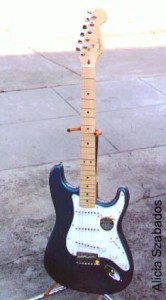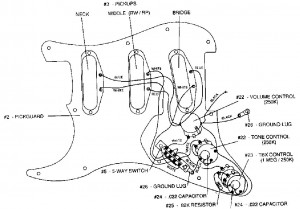 Year 2000 marks the end of the American Standard Stratocaster line and the introduction of Fender’s new American Series Stratocaster. Many marked refinements were incorporated in the new American Series Stratocasters that we’ll examine in the future. However, because the American Standard Stratocaster has been discontinued, it means that there are potentially great deals to be found in the marketplace. For that reason, as well as to mark the end of the American Standard Stratocaster’s 13-year life, LegendaryTones.com decided to examine some of the history of the American Standard Stratocaster as well as look at the year 2000 model in depth.
Year 2000 marks the end of the American Standard Stratocaster line and the introduction of Fender’s new American Series Stratocaster. Many marked refinements were incorporated in the new American Series Stratocasters that we’ll examine in the future. However, because the American Standard Stratocaster has been discontinued, it means that there are potentially great deals to be found in the marketplace. For that reason, as well as to mark the end of the American Standard Stratocaster’s 13-year life, LegendaryTones.com decided to examine some of the history of the American Standard Stratocaster as well as look at the year 2000 model in depth.
The first of Fender’s famous and long-lived American Standard Stratocasters was introduced in 1987 at the NAMM Convention and was a hit from the start. Fender was now in its post-CBS era, and the company’s new management team was committed to bringing Fender back to its glory days by again producing high-quality affordable instruments. In the 70’s especially, the CBS-owned Fender company suffered from a reputation for producing poorly-made guitars as a result of mass production and poor quality control. Being owned by mega-giant CBS did nothing but encourage the notion that the company only cared about profits. However, with new owners and the new American Standard model introduced, Fender clearly succeeded in time and the company again enjoyed a renewed reputation for producing quality instruments.
The idea of the American Standard Stratocaster was simple – take the best features found on the classic Stratocasters of the past and improve upon the other areas that could use some refinement. Some changes that were made included:
- Addition of an extra fret (from 21 to 22),
- Pickups with flush polepieces,
- Ezy-Glider string retainers and vibrato bridge with two screw mounts for added tuning stability,
- More consistent use of alder wood for the body (ash was a heavier and more inconsistent wood),
- Use of Biflex truss-rod,
- Return of the four-bolt neck mounting (from previous use of three in the 70’s),
- Schaller tuners,
- A polyurethane finish.
In addition, the bodies were now routed so that any number of pickup configurations could be used rather than just the traditional three single-coils. As the years progressed, further changes were incorporated from TBX tone controls and a new hotter Delta tone pickup system for increased output.
The American Standard Stratocaster changed relatively little during its existence, as Fender’s philosophy was obviously not to mess around too much with a good thing. By the time it came upon year 2000, American Standard Stratocasters were being produced in Fender’s newest Corona, California plant, with more attention to quality and detail being made than ever before.
Features
Our year 2000 Fender American Standard Strat came equipped with a one-piece all-maple neck, although Fender also offered (and continues to offer with the new American Series guitars) a two-piece maple neck featuring a rosewood fretboard. Our guitar also was finishined in a beautiful teal green metallic color that looks striking against its three-ply white pickguard.
While many of the refinements and changes in the American Standard Stratocaster were already identified earlier, a few should be elaborated on. The Biflex truss-rod offers easy adjustment of the neck’s angle in both directions unlike many standard truss rod assemblies that will only “pull” the neck against a concave direction. In addition, the neck’s radius is set to a medium-sized 9.5 inches and the frets are medium-jumbo in size and made of a combination of nickel and silver.
The electronics within the American Standard are fairly straightforward and traditional, except for the addition of the higher output Delta Tone pickups and TBX tone control system. See the wiring diagram to get more detail of the American Standard’s electronics. One area to note is that the middle pickup is wired out-of-phase to the bridge and neck pickups so that true humbucking modes can be selected from the American Standard’s 5-position selector switch.
Construction and Feel
 The fit and finish of the year 2000 Fender American Standard Strat are excellent. From the well setup action and the finely-cut nut, to the smooth polyurethane paint coat on the body and clear satin finish on the neck, it is clear that this Stratocaster has been crafted to exacting standards. The frets were also well installed, buffed, and even.
The fit and finish of the year 2000 Fender American Standard Strat are excellent. From the well setup action and the finely-cut nut, to the smooth polyurethane paint coat on the body and clear satin finish on the neck, it is clear that this Stratocaster has been crafted to exacting standards. The frets were also well installed, buffed, and even.
For those familiar with the feel of the Stratocaster, the American Standard plays as any well-made Stratocaster should. While many may prefer the heavy lacquers used on the necks on the vintage and vintage reissue instruments, I found that the neck’s clear satin finish felt very nice in that it was neutral. It was not too heavily lacquered and “sticky” like the finishes on the older Stratocasters, and not rough as an unfinished neck would be. Indeed, the satin finish gives a nice “slippery” feel overall. Bending strings and playing chords were both comfortable, especially against the smooth frets and satin finished neck. Again, this is excellent craftsmanship from Fender.
The Standard’s tremolo system is an improvement over the die-cast units used in previous generations. It is comfortable to use and functions well, however tuning stability was never its forte. By adding some lubricant to the string guide retainers and nut, friction was lessened and tuning improved quite a bit. Still, getting a Fender tremolo to stay in perfect pitch with aggressive use can be a problem. It’s best to use it for mild vibratos and keep all the friction points lubricated for the best results. My personal favorite tremolo system is the one used in the mid-90’s era Strat pluses that incorporated a roller nut, no string guides, locking tuners, and a Hipshot Tremsetter system. One could fairly easily add those features to the American Standard Stratocaster and I highly recommend that for those who are concerned over tremolo and tuning stability.
Sound
The Delta Tone Pickup system coupled with the TBX controls not only produce a hotter output than what was traditionally offered in a Stratocaster, but there is also an increase in the midrange frequencies as well. For blues players that need to wail, the Delta Tone system will certainly be welcome and allow leads to really cut through. The overall output, although hotter than a typical Stratocaster, is still nowhere near that of a Gibson Les Paul and this is a good thing. After all, each instrument has its own sonic characteristics and uses and what good would it be if all guitars had the same or very similar tones? Also another area to consider: single-coil pickups are noisy and susceptible to interference and other electrical issues. For those that choose to keep the tones clean or add a minimal amount of overdrive, it’s o.k. However, those who want to seriously rock with a Stratocaster by adding gobs of gain would be better served by replacing the stock pickups with “stacked” humbuckers (such as DiMarzio’s Virtual Vintage Series designed to fit and appear “stock”), Lace Sensors (available in different variations of gain), or Fender’s new line of vintage noiseless pickups.
Moving on to the tone controls, the tone configuration has basically remained in a traditional form since the Stratocaster’s inception and I don’t personally understand the value of a separate tone control for the neck pickup and then a shared control (TBX) for the bridge and middle pickups. Dare I suggest that we break with tradition, but for me personally, it would seem one overall tone control with two volume controls for the neck and bridge pickups would serve me best, but that’s just my take. I do understand that if Fender made some changes such as this, public outcry would perhaps be too strong – you just don’t break with tradition after all. I recall in the early 80’s, Fender – while still under the ownership of CBS – tried to cut production costs by removing the input jack assembly and receptacle from the body, and instead replaced one of the tone controls with a newly relocated ¼” jack directly on the plastic pick guard. Needless to say, not only did many of the pick guards crack in time, but this move certainly didn’t go over well with players. When all is said and done, perhaps it is best to leave the Stratocaster as it is! Fender must be doing something right to continue on with a design that is over forty years old.
Besides the two tone controls, the American Standard Stratocaster incorporates a single volume control that is easily accessible with your picking hand’s pinky. Careful rolling back of the volume knob will warm up the sound a bit to incorporate a softer touch or to facilitate an aggressive attack with more of a classic blues feel. I found that the American Standard Stratocaster’s tones were inspiring; the subtle changes I made to the instrument’s controls or with my playing consequently seemed to be an extension of various playing moods I was trying to express. The blues could be warm or piercing. Rock chords could be pounded out aggressively and produce a sound that was over-the-edge. Additionally, Playing the neck pickup added an even warmer and smoother sound, perfect for jazz.
Conclusion and Overall Rating
With the American Standard Stratocaster’s sonic versatility and feel, it’s easy to get comfortable with it and it is no wonder that the Stratocaster has won over legions of players. And because the American Standard Stratocaster is not a high-priced custom shop model where being collectable is an issue, it certainly can be thought of as a true player’s guitar.
With year 2000 drawing to a close, we’d like to give the year 2000 American Standard Stratocaster a retirement rating worthy of its legacy. It may not be the perfect guitar for everyone, and it is certainly not the most refined or exotic instrument available, but the American Standard Stratocaster is clearly as elegant an instrument as any in its simplicity and functionality. In addition, its comfort-contoured body is a timeless design that is a lasting testament to its name. Compare the feel of a Stratocaster body versus a Telecaster body against you and you’ll immediately feel the difference. If LegendaryTones rated the year 2000 American Standard Stratocaster based on other comparative Stratocasters produced over the last 25 years, it would clearly earn a perfect 10 score. However, we need to examine the American Standard Strat for its value overall as a guitar. For its tonal versatility, playability, and good value, LegendaryTones.com gives Fender’s year 2000 American Standard Stratocaster a well-deserved score of 9.